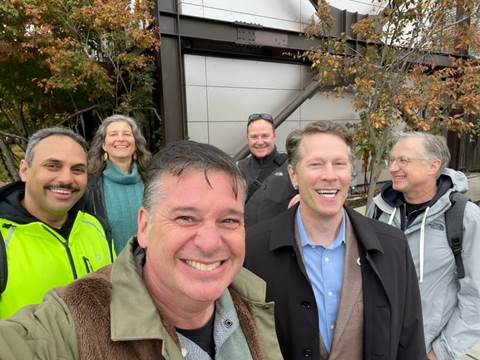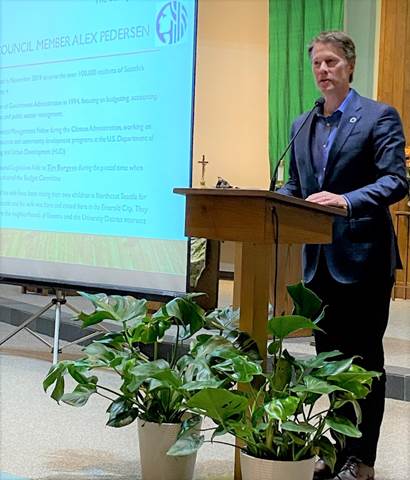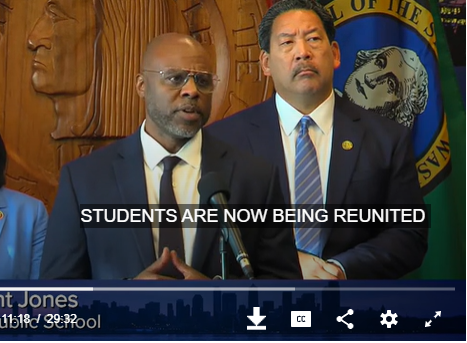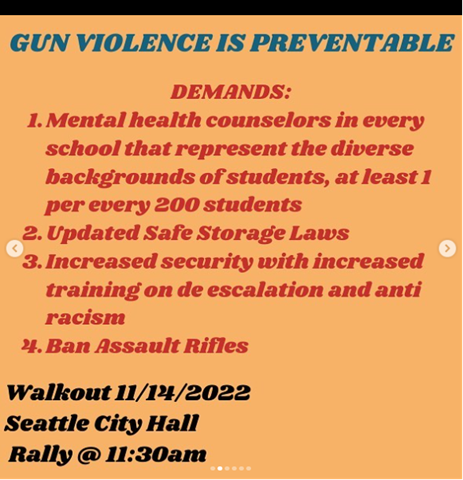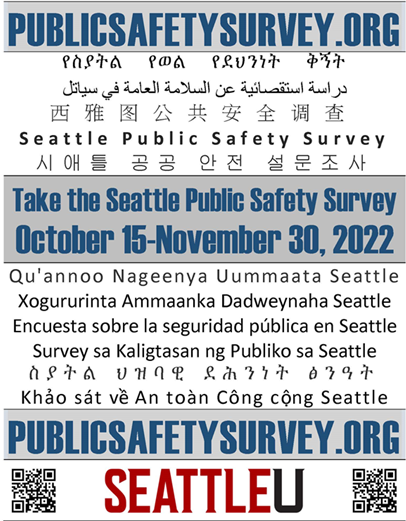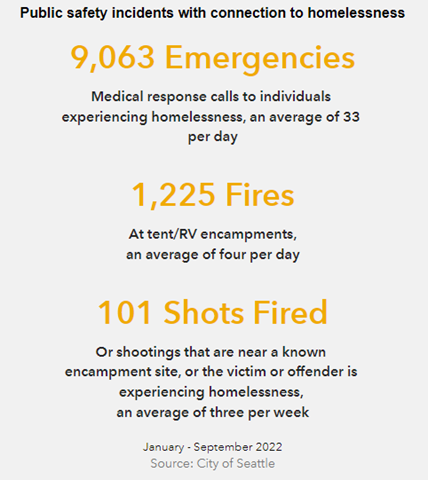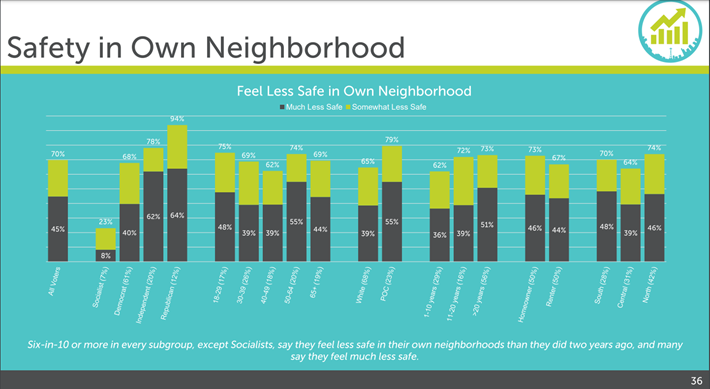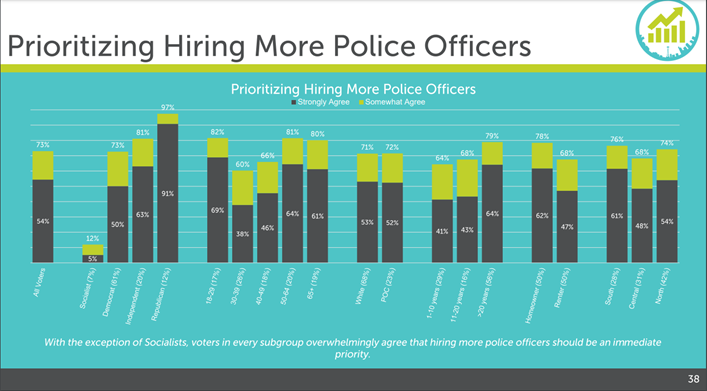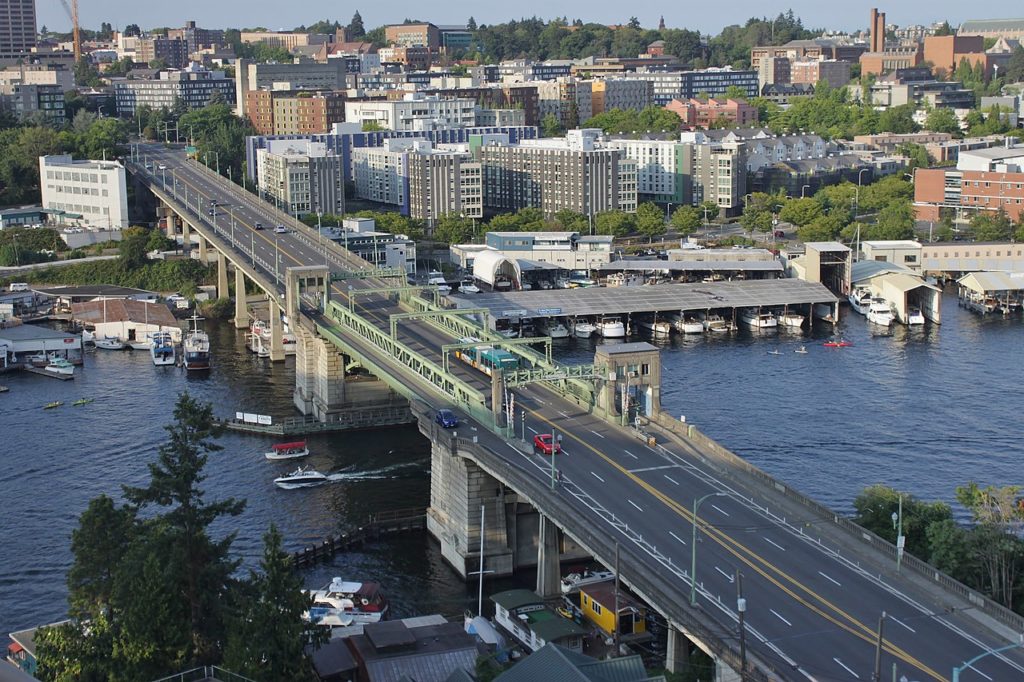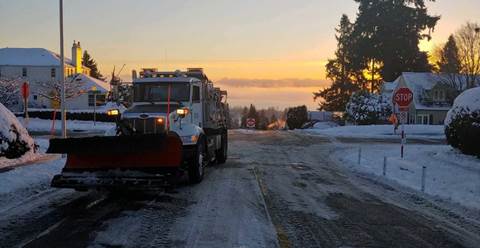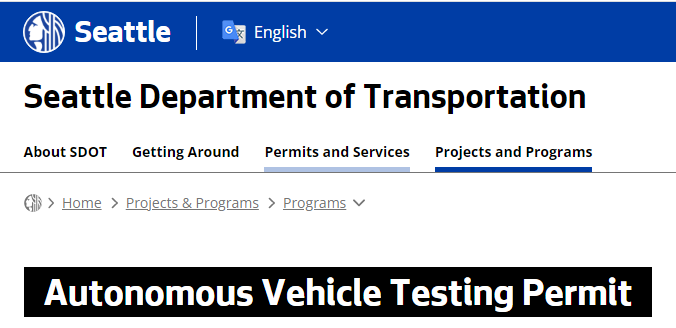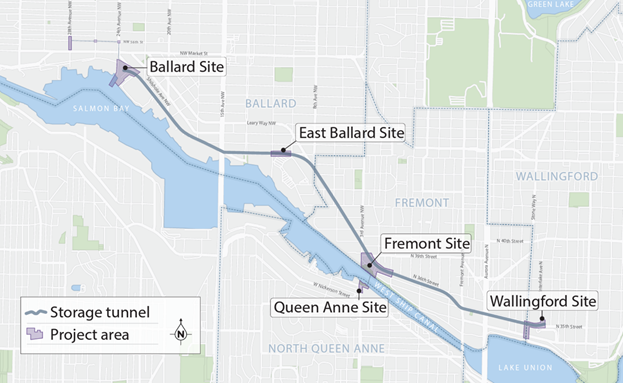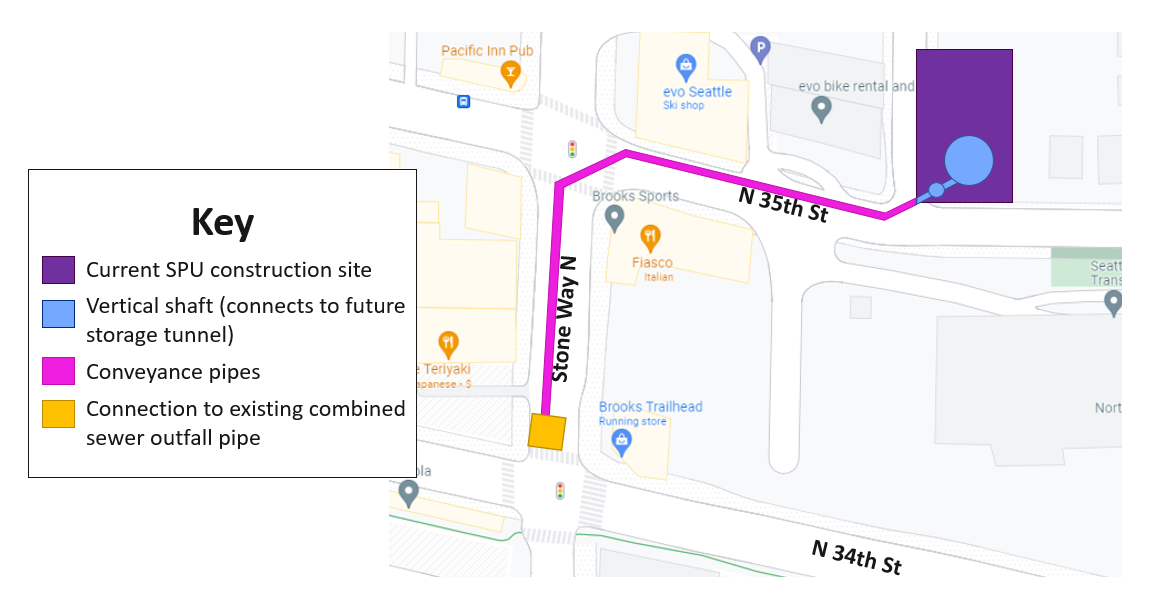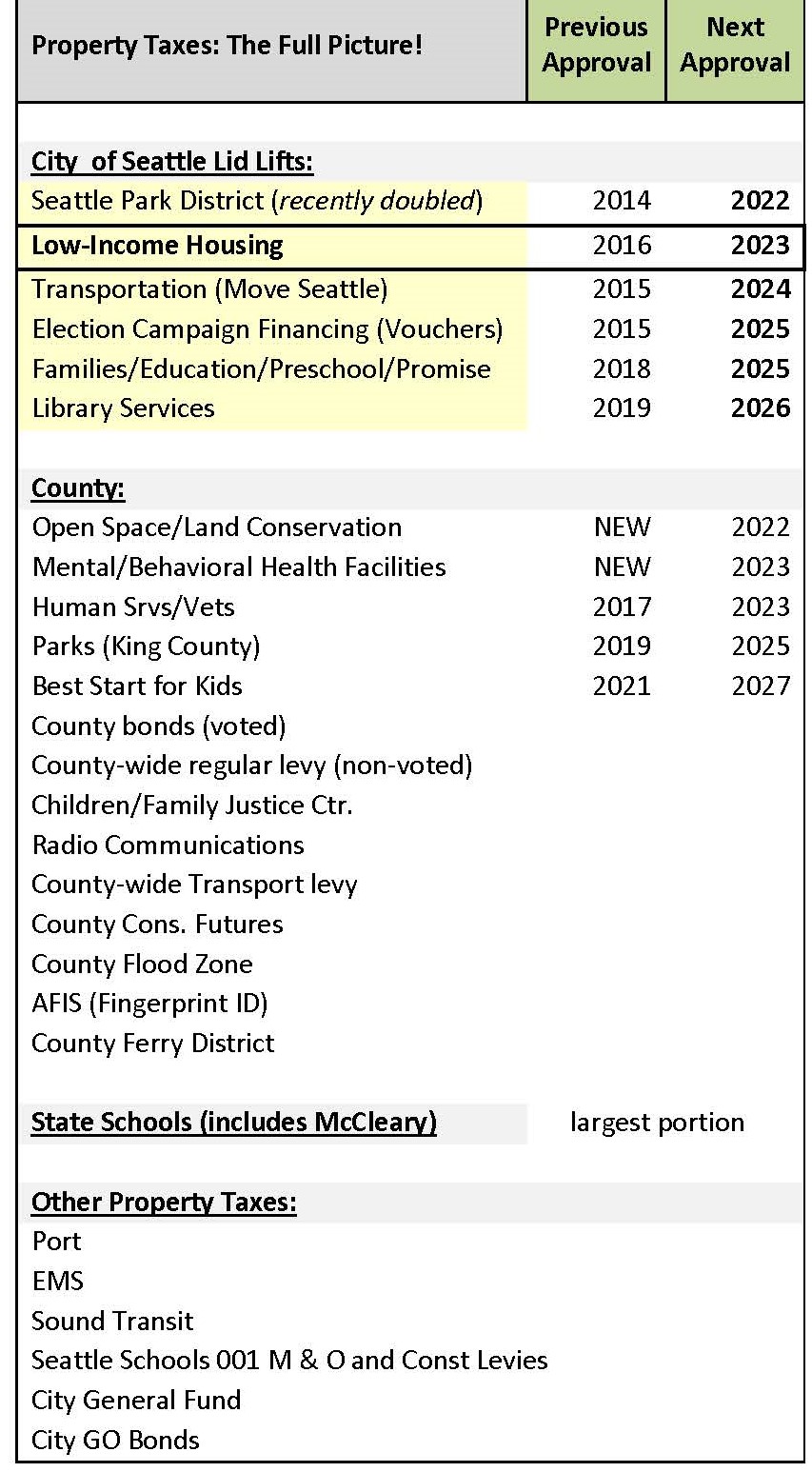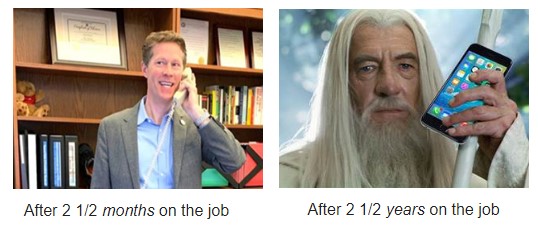Standing Up for Public Safety in the City Budget
Friends and Neighbors,
Our November newsletter focuses on the final decisions allocating Seattle’s $7.4 billion budget to address the issues that concern you the most. As I mentioned in my October newsletter, I realize that reducing homelessness and increasing safety remain the top concerns across Seattle and so my efforts during the budget review process generally supported Mayor Harrell’s original budget proposals on those two important challenges.
Please click on the links below to zip to the sections that interest you the most:
- District 4: Engaging in Bryant, the U District, View Ridge, Wallingford, Wedgwood, and more.
- Public Safety and Homelessness: Adding mental health supports; taking the Seattle University Survey; and 3RD quarter report on homelessness.
- City Budget: A tough No vote on final City budget because it fails to optimize public safety policies and investments; Also, a summary of successful amendments on transportation (bridges!) and the environment.
- Transportation & Seattle Public Utilities Committee: meeting next on December 6; finally requiring accountability for testing autonomous vehicles; and preparing for winter storms.
- Other Issues: Low-Income Housing Property Taxes and Comprehensive Planning Participation.
- Providing Input.
For my previous newsletters, you can CLICK HERE to visit my website/blog. Thank you for caring enough to demand the best from City Hall.
DISTRICT 4
Pedestrian Safety Connecting Wallingford and U District
With Seattle’s new SDOT Director and “Selfie Maestro” Greg Spotts, along with his top-notch team, experiencing firsthand the I-5 overpass connecting Wallingford to the U District this month. Initially advocated by community groups and pedestrian safety advocates, I have not given up on making sure we fund and build simple safety improvements to make it safer to cross over I-5 at NE 45TH Street for both pedestrians and cyclists. As discussed later in this newsletter, I’m grateful to City Council colleagues for joining me in adding $1.5 million to SDOT to complete the safety improvement project that will add fencing to protect pedestrians and bicyclists on the I-5 overpass on NE 45th Street (SDOT-104-B-001-2022). I’m grateful the majority of us agreed that a proposed $10 increase in Vehicle License Fees (VLF) would be the source of funds for this overpass pedestrian project in 2023 — with future funds going 50/50 toward other Vision Zero pedestrian safety projects as well as to bridge maintenance (via Council Budget Action SDOT-505-B-002-2023).
Community Councils Thank You
A special thank you to the various community groups throughout our District 4 that invited me to speak during the past month (in alphabetical order): Inverness Community Council, North Precinct (Police) Advisory Council, Ravenna-Bryant Community Association, View Ridge Community Council, and the Wallingford Community Council. My team and I always appreciate the insightful questions and ideas we receive at your meetings. Everyone: joining your community council is a great way to get involved in local government. To invite me to your community council meeting, just write to Alex.Pedersen@seattle.gov .
“Tent City 3” Concerns
Many residents from the Bryant and Wedgwood communities have raised concerns and questions about an altruistic proposal by the University Unitarian Church located at 6556 35TH Ave NE to host from March through May 2023 the so-called “Tent City 3,” which is a homeless encampment that is currently authorized by city code and is typically hosted on church parking lots. (In fact, Tent City 3 is currently in District 4 in the parking lot of a different church.) Questions about Tent City 3 should be directed to the Unitarian Church at the following email address: uuchomelessness@gmail.com
Even though questions should be directed to the Unitarian Church, my office receives many questions, so I’ve created a blog post to answer some of the questions: CLICK HERE.
Note: Tent City 3 is different from Rosie’s Tiny Home Village located in the U District, which has professional case management and tracks the number of people transitioning successfully to affordable housing.
PUBLIC SAFETY and HOMELESSNESS
Tragic Shooting Death of Student at Ingraham High School November 8
Dr. Brent Jones, head of Seattle Public Schools, addresses the media with Mayor Bruce Harrell on November 8, 2022. (photo from Seattle Channel)
On Tuesday, November 8, 2022 at 9:55 a.m., “…police received reports of a shooting at [Ingraham High] school, in the 1800 block of North 135th Street. Officers arrived and formed contact teams to immediately enter the school. Police found one person with a gunshot wound and provided aid until Seattle Fire Department medics transported the victim with life-threatening injuries,” according to SPD’s online report. By 11:10 a.m., officers apprehended the suspected shooter and a potential accomplice in North Seattle.
- For SPD’s original announcement on their “Blotter,” CLICK HERE.
- For Seattle Times coverage, CLICK HERE.
Here are excerpts from Mayor Harrell’s statement on November 8, 2022:
“Today, a tragedy occurred at Ingraham High School in North Seattle. My heart breaks for the student who lost their life and for their family, friends, and the entire Ingraham High School community impacted by this senseless act of violence. Schools must be safe havens for our youth to learn, grow, and thrive, and our students must trust that they will be safe in the classroom.
Gun violence has impacted too many families in our city, and we can never accept this as normal. The solution requires a holistic approach – law enforcement, community-based solutions, pathways for prevention and intervention, and the ability to set our own gun safety laws.
I want to thank the first responders from the Seattle Fire Department and Seattle Police Department who acted swiftly and bravely to respond to the incident. These teams deserve our heartfelt appreciation and gratitude. I am also grateful for the courage and compassion of the teachers and staff at Seattle Public Schools who helped immediately identify the suspect and worked to support our students at this trying time…”
Here are excerpts from our Public Safety Chair’s statement on November 8, 2022:
“This is devastating. My heart goes out to the victim, their loved ones, and the students, staff, families, and neighbors of Ingraham High School. No student should have to go to school worrying about the threat of gun violence. No parent should have to experience the heart-wrenching feeling of wondering if their child is safe at school. This is unacceptable…
Seattle has a gun problem. I sincerely thank all of the first responders and school faculty today. I want to specifically thank the Seattle Police Department for their work seizing 1,237 illegal firearms last year, an unheard of number, and we’re on track to meet or exceed that with over 1,000 seizures already this year. Whether it’s through gun violence prevention we do at the city and county level or gun control legislation passed at the state and national level, we must do more. Our kid’s lives depend on it.”
While the Seattle school district is a self-governing agency with its own resources from the federal and state governments and its own property tax levies for capital projects and operations, the city government of Seattle supports public schools through a separate Families and Education (K through 12), Preschool, and Promise (community college) property tax levy. That city government-driven levy funds the City’s Department of Education & Early Learning (DEEL).
Some question whether the city government has succumbed to expensive and distracting “mission-creep” with the DEEL levy, but I support it because schools are historically underfunded and education is so vital to our democracy and the wellbeing of our residents. But, I digress. The point is that, for a city government, Seattle provides an unusually large number of resources to our public schools. So, when additional needs arise, it’s no surprise that student leaders might come to City Hall, in addition to the Seattle School District, to seek additional support. I stood with and heard the suggestions of the student leaders when they came to City Hall on November 14, 2022. While the Mayor and our Budget Chair found additional resources, it’s really several high school student leaders who deserve the credit for coalescing around requests that included more dollars for mental health support.
Thanks mainly to the most recently voter-approved property tax increase for education (2018), the City government contributions through the DEEL budget exceed $125 million per year, including $40 million to support K through 12 public schools. This already includes funding for School-Based Health Centers managed through a contract with Seattle-King County Public Health.
In response to requests from several current student leaders after the shooting at Ingraham High, the Mayor and Budget Chair Teresa Mosqueda collaborated (with City Council support during her committee) to add at least $3 million for mental health services: $1.5 million for each of the next two years with two budget actions: DEEL-002-A-001-2023 and DEEL-603-A-001-2023. (This included a set aside for Ingraham High of at least $250,000 via DEEL-601-A-001-2023 sponsored by Council President Juarez whose district includes that school.) This would increase funding for School-Based Health Centers to $9.4 million in 2023 and $9.6 million in 2024, with a portion specifically allocated for expanded mental health services in schools. For some of the existing mental health services at Seattle Public Schools, CLICK HERE.
For “Tips for Parents and Teachers: Talking to Children About Violence” from The National Association of School Psychologists, CLICK HERE. Here’s an excerpt: “High profile acts of violence, particularly in schools, can confuse and frighten children who may feel in danger or worry that their friends or loved-ones are at risk. They will look to adults for information and guidance on how to react. Parents and school personnel can help children feel safe by establishing a sense of normalcy and security and talking with them about their fears.”
Participating in the “Before the Badge” Training
An SPD Research Team will continue to facilitate community-police dialogues with new recruits from the Seattle Police Department’s “Before the Badge Program” through December 2022 on Monday nights 5:30-7:30 p.m. They are inviting the public to participate in this special series of dialogues that will focus on community engagement with the new Seattle Police recruits.
The dialogues are part of the new “Before the Badge” 45-day training program that all new Seattle Police Department recruits complete PRIOR TO entering the Washington State Basic Law Enforcement Academy. The purpose of the dialogues is to give community members an opportunity to engage with new Seattle Police recruits to help them learn about Seattle community concerns at the precinct/neighborhood level as part of the Seattle Police Department’s Micro-Community Policing Plans (MCPP) .
This is an opportunity to be part of the SPD training process. You can sign up today. Feel free to share with all who live and/or work in Seattle. Sign-up to participate in the new “Before the Badge” Community-Police Dialogues!
12/5/2022 5:30-7:30PM – North Precinct (includes Council District 4).
12/12/2022 5:30-7:30PM – South Precinct.
12/19/2022 5:30-7:30PM – Southwest Precinct.
Take the Public Safety Survey by Seattle University
The 8th annual public safety survey is led by Dr. Jacqueline B. Helfgott, professor of Criminal Justice and director of the Crime & Justice Research at the Seattle University Department of the Criminal Justice.
The Seattle Public Safety Survey is being administered Oct. 15 through Nov. 30, 2022 in 11 languages.
- To take Seattle’s Public Safety Survey, CLICK HERE.
- For the October 10, 2022 Op Ed in the Seattle Times highlighting the public safety survey and explaining elements of Seattle’s “Before the Badge” orientation program, CLICK HERE.
- For a Seattle Times article about the public safety survey, CLICK HERE.
Homelessness: 3rd Quarter 2022 Results
Source: Mayor’s Homelessness Action Plan website.
While we have shifted primarily to a regional approach to reduce homelessness, the City provides substantial funding to that effort while still engaging with some illegal encampments on City government property and, of course, substantially subsidizing the production of low-income housing.
Seattle Mayor Bruce Harrell recently released third quarter 2022 updates for his Homelessness Action Plan. These new data sets came on the heels of Mayor Harrell’s transmittal of his 2023-24 budget proposal to the City Council, which included the City’s investments in City-managed homelessness response services, the City’s Unified Care Team, and the King County Regional Homelessness Authority (KCRHA).
The information is for the 9-month period from January (when the Mayor took office) through September 2022, and the data is disturbing: 9,063 emergencies, 1,225 fires, and 101 shots fired. The Mayor’s office also compares the most recent quarter (3-month period) to the previous quarter. The snapshot for just the 3rd Quarter (July through September 2022) of unauthorized encampments includes 724 documented tents and 273 documented RVs located throughout the City—a measurable reduction in encampment site numbers since the end of June 2022. Nearly 20% of all citywide shootings/shots fired through Q3 have a nexus to an unauthorized encampment or a person experiencing homelessness.
As of September 2022, the City has identified 1,912 new units of shelter and housing, 88 units away from the goal of 2,000 by the end of 2022.
For regional policies on addressing homelessness and for encampments on State government property (such as the dangerous encampment under I-5 near NE 42nd Street), constituents can contact the King County Regional Homelessness Authority through their CEO Marc.Dones@kcrha.org or use their contact page by CLICKING HERE.
CITY BUDGET AND TAXES
Explaining a Tough “No” Vote on the Budget Amended by City Council
[Note: the portion in bold below is what I said at the final Budget Committee on November 28, 2022.]
It’s often said that a government budget should reflect what is valued most. Public safety is the issue I hear most about from constituents. We also hear from leaders in other parts of Seattle, including Reverend Harriet Walden of Mothers for Police Accountability and Victoria Beach of the African American Community Advisory Council urging support for the Mayor’s original public safety budget. City leaders receive dozens of similar emails and phone calls from residents who want City Hall to do more to advance our public safety responsibilities under the City Charter.
A recent survey of Seattle residents confirmed 69% think our city is on the wrong track, and they cite crime and homelessness as the top concerns. The public’s concern about crime & public safety has increased sharply from just 28% citing it as a top concern last year to nearly half of the people citing it as a top concern today. Their experiences and concerns about crime are supported by the data: Emergency 911 response times and crime rates have, in fact, worsened.
On November 14, Councilmember Sara Nelson and I published our numerous concerns about changes being made to Mayor Harrell’s original budget proposal — changes that could hamper efforts to increase public safety. We listed seven public safety concerns to fix. Unfortunately, the Budget Committee on November 21 fixed only one of the seven public safety concerns.
I appreciate all the hard work of the Mayor’s Office, the City Budget Office, and the various departments to craft the budget as well as the long hours invested by our Budget Chair and legislative staff to amend the budget. This budget provides many positive investments for our city’s infrastructure and our most vulnerable residents, which I supported during the lengthy amendment process. Regarding the overall final budget, I appreciate the rationale of the independently elected officials who have chosen to vote in favor of it. Having worked on dozens of budgets at various organizations in multiple cities, I realize most budgets are compromise documents unlikely to contain everything that everyone wants. I have sometimes celebrated budgets and sometimes held my nose to vote for budgets despite their shortcomings.
My team and I worked hard and in good faith throughout this budget process to get to a Yes. But it’s become clear to me there’s more at stake here in Seattle regarding public safety today, and I believe a City budget — after two months of discussions and amendments — should do MORE for public safety, not less.
Unfortunately, this budget as amended:
- Deletes (abrogates) 80 police officer positions from the books despite a severe staffing shortage and that sends a negative message to our officers and potential recruits, even though the maneuver doesn’t save money. (Note: the Mayor’s recruitment plan aims to restore us to 1,450 funded and deployable officers: https://harrell.seattle.gov/wp-content/uploads/sites/23/2022/07/SPD-Recruitment-and-Retention-Plan.pdf, so “abrogating” positions clearly goes in wrong direction.)
- Prevents the Seattle Police Department from using salary savings to fund overtime needs during the severe staffing shortage and fails to fully support officer recruitment and retention efforts.
- Fails to fund a pilot program to treat methamphetamine addiction, a driver of violent crime and debilitating mental illness, as originally proposed by Councilmember Nelson.
- Fails to fund gunshot detection technology requested by Mayor Harrell.
- Fails to fund additional graffiti removal requested by Mayor Harrell.
- Fails to fully fund Mayor Harrell’s innovative approach to getting more people into housing with the City’s Unified Care Team, as we await quicker action from the new Regional Homelessness Authority.
While I appreciate all the hard work to fund infrastructure and human services programs to benefit Seattle and our district, I believe the City Council’s budget amendments went too far in weakening the Mayor’s original priority of public safety and could undermine efforts to recruit and retain police officers and detectives as Seattle struggles with 9-1-1 response times and crime rates.
It’s tempting at City Hall to “go along to get along” to avoid conflict with colleagues, but I ultimately believe each elected official should vote their conscience as they strive to synthesize the concerns and input from their constituents. While I join my colleagues in supporting several elements of this $7.4 billion budget, I cannot in good conscience endorse a final budget that I believe fails to learn from recent public safety policy mistakes and falls short on public safety for a third year in a row. So I will be voting No on this final budget.
I’ll look forward to working with the Mayor and Council colleagues next year to make sure the budget fully funds public safety. Thank you.
- For the “call to action” I co-authored with Councilmember Sara Nelson on November 14, 2022 in favor of Mayor Harrell’s original budget released September 27 and in response to our public safety concerns with the Budget Chair’s November 14 re-balancing package, CLICK HERE.
(For an alternative view on these issues, CLICK HERE.)
OTHER AMENDMENTS:
I continue to hear from constituents that the top two issues facing Seattle remain public safety and homelessness. In general, I supported the Mayor’s original budget proposals for those two big issues. (See comments above regarding the “No” vote.) While the Budget Committee, unfortunately, deleted too many of Mayor Harrell’s public safety proposals, there were bright spots for several of the amendments I sponsored, especially regarding transportation and the environment. I appreciate the support of colleagues who voted in favor of these amendments, and I was pleased to support many of their amendments as well. For a visual overview of Council amendments, CLICK HERE.
Protecting Our Environment:
- Creating a “City Urban Forester” (“Chief Arborist”) within the tree-friendly Office of Sustainability & Environment. This position will have jurisdiction across City departments to lead the conservation and planting of tree infrastructure to strengthen Seattle’s resiliency to climate change. This follows through on our efforts from last year. (OSE-005-B-001-2023) PASSED!
- Accelerating Phase Out of Harmful Gas-Powered Leaf Blowers to support public health, workers, and our environment. While the Budget Committee Chair rejected our modest request to add $200,000 to pay for electric leaf blowers for the Seattle Parks Department so that we could implement Resolution 32064, my team got creative to solve the problem without money: we adopted a budget requirement (proviso) to prohibit the Parks Dept from buying any new gasoline-fueled leaf blowers. Therefore, we will speed up the process to improve public health, working conditions, and the environment through attrition of this harmful equipment. I sincerely appreciate the can-do attitude of Mayor’ Harrell’s new Parks Superintendent AP Diaz who confirmed to me last week that he is onboard with getting rid of gas-powered leaf blowers. The Parks Department owns the most gas-powered leaf blowers and, unfortunately between 2014 and 2022 purchased 145 gas-powered leaf blowers, and now that department owns 270 of these polluting machines. These leaf-blowers last approximately five years, so this proviso creatively enables us to advance the goals of our Resolution by requiring replacement leaf blowers to be electric. (The Dept already has 30 electric leaf blowers.) Per the unanimously adopted Resolution 32064, the city government will lead by example and be the first in Seattle to ban gas-powered leaf blowers among its various departments by January 2025. We can then focus on working with the private sector on solutions to phase out the harmful machines completely by January 2027. (SPR-004-B-001-2023) CHANGED TO PROVISO AND PASSED!
Addressing Equity:
- Attempting to require the Office of Planning and Community Development (OPCD) to explain how it will prevent the displacement of existing residents. OPCD’s published materials seem to emphasize build, build, build new market-rate housing as their main tool to “prevent” displacement of existing residents, but it should be using other tools, such as minimizing demolitions of existing affordable housing and maximizing the amount of new housing dedicated to low-income residents (i.e. those most in need). The Budget Chair did not include our request, despite it having no cost. (OPCD-002-A-001-2023). REJECTED.
- Bridging the Digital Divide in Seattle by making progress on the “Internet for All” Resolution 31956 That Resolution generated an Action Plan to expand access to affordable high-speed internet, so that less fortunate neighbors can access education, jobs, medical care, and other information vital for a strong democracy. Despite being a high-tech city, there is still a digital divide, so we must do more to close that gap. A recent study confirmed racial disparities in the quality of internet service in several cities — including Seattle. While the Budget Chair cut in half our original request, I appreciate her partially funding the additive dollars to digital equity: We are adding $225,000 to the Technology Matching Fund (TMF) and “Digital Navigators” (DNs) to help people connect to the internet in 2023 and another $225,000 in 2024 (specifically adding $135,000 to TMF and adding $90,000 to DNs each year). (Ip-001-B-001-2023). PASSED AT A LOWER AMOUNT.
Expanding Pedestrian Safety:
- Making safe the treacherous NE 45th Street I-5 overpass that connects Wallingford to the new light rail station in the U District, a Vision Zero project promised by the Move Seattle Levy. Add $1.5 million to SDOT to complete the safety improvement project that will add fencing to protect pedestrians and bicyclists on the I-5 overpass on NE 45th Street (This follows through on the studies already funded and completed during the past two years.) (SDOT-104-B-001-2022). Note: I’m grateful we agreed that a proposed $10 increase in Vehicle License Fees (VLF) would be the source of funds for this overpass pedestrian project in 2023 — with future funds going 50/50 toward Vision Zero pedestrian safety projects and bridge maintenance via SDOT-505-B-002-2023. PASSED!
- Doubling the School Safety Zone Speed Enforcement Cameras: Currently only 19 out of 100 Seattle public schools benefit from this Vision Zero effort to protect young pedestrians. Thanks to our amendment and support from the Budget Chair, we are adding $1 million in 2023 and more in 2024 to increase the number of enforcement cameras from 35 to 70 to cover 40 locations. An additional upside: this program earns money so that it can pay for itself AND reinvest net revenues into more pedestrian safety! SDOT-103-B-001-2023 and SDOT-304-A-001-2023. PASSED!
- Saving the Neighborhood Street Fund “Vision Zero” safety projects! The Move Seattle Levy Oversight Committee reviewed and approved 17 projects. Because these community-driven pedestrian safety projects will cost $7.6 million and yet the levy had only $4 million, we proposed an amendment (SDOT-105-A-001-2023) to fund the remaining $3.6 million. The Budget Chair, unfortunately, rejected that request and so my team reduced the request to fund the Neighborhood Street Fund project that was transit-related and in the University District near 41st Street and Roosevelt Way (just north of the University Bridge) SDOT-604-A-001-2023. MODIFIED AND PASSED!
Finally Boosting the Safety of Seattle’s Bridges:
- A recent poll confirmed that “maintaining bridges and infrastructure” remains a top concern for Seattle residents. Our City Auditor recommends investing a range of $34 million to $102 million annually just to maintain Seattle’s aging bridges, but year after year, we have short-changed this vital infrastructure by funding much less than $34 million. There are several budget line items deemed by our City Auditor as “bridge maintenance.” Unfortunately, as proposed by the Seattle Department of Transportation (SDOT), the original budget failed to provide an overall increase in those bridge maintenance items. That was hugely disappointing and perplexing considering SDOT had earlier rejected the $100 million in bonds that we authorized for bridge safety. To make matters worse, an amendment advanced by the Budget Chair (SDOT-909-A-002-2023) moved the City in the wrong direction by cutting by $3.2 million from one of those bridge maintenance line items. With the 2 ½ year shupown of the West Seattle Bridge, other bridges getting stuck, and the disturbing audit I ordered in 2020 showing our bridges in bad condition, it’s clear we need to invest more now.
- Therefore, I put forward several proposals that would add up to the minimum annual investment recommended by the Auditor — a sensible downpayment toward addressing this vital infrastructure need. In addition to using half of the funds generated in the future from the $10 increase in the Vehicle License Fee (VLF), the largest source for multimodal bridges (carrying buses) is the Seattle Transportation Benefit District (STBD). Another amendment we passed will temporarily increase and tap the dollars authorized for the capital projects category as well as deploy unused reserves currently sitting dormant in the STBD account. The City’s capital projects category can be increased, in part, because other levels of government are paying now for the “free” youth fares. As transit ridership increases after 2023, the capital category dollars will be available for additional transit service hours. In the meantime, overdue bridge maintenance projects (including for our District’s aging University Bridge) can improve the safety, speed, and reliability of clean, public mass transit. When a bridge breaks or closes or malfunctions, the speed and reliability of transit relying on that bridge drops to zero. No bridge, no bus. I appreciate a majority of my colleagues recognizing this need and approving the resources to care for Seattle’s aging multimodal bridges. Residents, businesses, and workers expect City Hall to keep Seattle’s aging bridges open and safe to keep our communities connected and our economy moving. Now, once again, we need SDOT to follow-through and use those funds to fix our bridges. (SDOT-502-C-001-2023 successfully replaced SDOT-502-B-001-2023) PASSED! (Thanks also to the transfer of Parking Enforcement Officers (PEOs) back to SPD, which saves money to redeploy to other priorities — including nearly $1 million toward bridge maintenance.
(For an alternative view of my amendments to STBD in a thoughtful blog post that expresses concerns, CLICK HERE. In brief response, I would add that the authorization we provided to SDOT is temporary.)
MORE BUDGET INFO:
- For Mayor Harrell’s original budget proposal for 2023 calendar year, CLICK HERE. For the Mayor’s September 27, 2022 press release, CLICK HERE. To read his speech as originally written, CLICK HERE. To watch his speech, CLICK HERE. For the lengthy budget documents, CLICK HERE.
- To watch Councilmember Pedersen’s District 4 Budget Town Hall from October 19, 2022, CLICK HERE. Many thanks to all the constituents who took time from their evenings to join us!
- For the agenda of the big meeting of Budget Committee amendments on November 21, 2022, CLICK HERE and to watch that video, CLICK HERE for Part 1 and CLICK HERE for Part 2 (For my comments against abrogating/deleting police positions, go to minute 2:37:34 of Part 2.) For a tool to see whether each Councilmember’s amendments passed, CLICK HERE.
- For the final Budget Committee agenda for November 28, 2022, CLICK HERE. For the full City Council agenda for November 29, 2022 when the Council adopted the budget with a 6 to 3 vote, CLICK HERE.
- For the Seattle Channel video of my remarks about voting NO at the final Budget Committee on November 28, 2022, CLICK HERE.
- For the Budget Chair’s website for the Budget Committee, CLICK HERE.
- For the Budget Chair’s press release after passing the budget 6-3, CLICK HERE.
- For an interactive guide demystifying Council’s two-month review process, CLICK HERE. Pro Tip: Get the Mayor and his executive City departments to insert your budget request into their original proposal between April and September. Why? Because once the mayor submits his budget, he’s “used up” all the available revenue and so it’s difficult to (a) find additional funds AND (b) garner the support of the Budget Chair AND the rest of the Councilmembers to make changes.
- For the existing City budget adopted November 2021 for calendar year 2022 and previous budgets, CLICK HERE.
TRANSPORTATION & SEATTLE PUBLIC UTILITIES COMMITTEE
(This is the Committee currently chaired by Councilmember Pedersen, so we provide extra information on its issues.)
Regular meetings of ALL Council Committees were paused during our two-month review of the City Budget in October and November. Our Committee meets again on Tuesday, December 6, 2022. We will also be hosting a special meeting on Monday, December 12, 2022.
Preparing for Winter Storms
Snowy view from View Ridge during a recent winter.
For tips on handling winter storms and help from your city government, CLICK HERE for my blog post and CLICK HERE for the latest winter storm info from the Harrell Administration.
Many thanks to the frontline City government workers in the field who strive to keep our streets open and to the transit operators who keep things moving during winter storms!
Autonomous Vehicle Testing: Street Use Permits Required Now for Safety
We heard from Seattle residents concerned about the safety of our streets, crosswalks, and sidewalks as private corporations attempted to experiment with their autonomous vehicle technologies on our public roads. We heard the problem and implemented a solution. To balance our interest in the future benefits promised by autonomous vehicle technology with our immediate responsibility to keep everyone safe today, I worked with our Seattle Department of Transportation (SDOT) to require companies seeking to test autonomous vehicles on our public streets to comply with reasonable rules for safety, notification, reporting, indemnification, and insurance. Consistent with State law, the City of Seattle is requiring these companies to obtain Street Use Permits before testing on our public streets. This is a sensible step for basic safety, transparency, and accountability.
I appreciate SDOT’s collaboration and strategic thinking on this complex issue. I’m also grateful to local journalists for raising this concern from communities. For the October 2021 article from the Seattle Times, “Self-driving cars are coming to downtown Seattle; Safety advocates are not pleased,” CLICK HERE.
For SDOT’s new website for Street Use Permits, CLICK HERE.
Mega Project Update: the Ship Canal Water Quality Control (including East Fremont and Wallingford)
Overview: The Ship Canal Water Quality Project is a “mega project” planned over many years due to the state and federal governments requiring the city and county governments to prevent harmful stormwater and wastewater from polluting our local waterways. With a cost estimated of at least $570 million (shared with King County), this environmental protection project includes a new tunnel-boring machine starting its work in 2021. This ambitious 2.7-mile long, 19-foot diameter stormwater storage tunnel should be completed by 2025.
In some parts of Seattle, sewage and stormwater (rain) share a set of pipes underneath our city streets; this is called a “combined sewer.” During heavy rains, the untreated water often exceeds the pipes’ capacity (known as a combined sewer overflow or CSO), which then dumps portions of the untreated sewage and stormwater into our natural waterways. These polluted overflows can harm our environment, including fish and wildlife. This environmental protection project will enable us to store 29 million gallons of untreated sewage and stormwater during large storm events, until the treatment plant it ready to process it over time. Because every year has multiple storm surges with combined sewer overflows, the storage capacity translates into preventing approximately 75 million gallons of sewage laden waters annually from contaminating our precious waterways — from Salmon Bay to Lake Union.
Because this is one of the most expensive projects ever undertaken by the City of Seattle and it involves multiple layers of government, additional scrutiny is warranted to ensure the project is on time and on budget. Like most large capital projects, the Ship Canal Water Quality Control Project is on the City’s Capital Projects “Watch List” so that it receives extra attention.
Temporary Traffic Disruptions on Stone Way to Enable This Capital Project / Environmental Improvement:
Work in Stone Way between N 34th Street and N 35th Steet likely to begin January 2023 and last for approximately 1 year. Vehicles heading west on N. Northlake Way can still access N 34th Street.
As part of the Ship Canal Water Quality project, SPU needs to build new conveyance pipes (and very deep trenches for them) along Stone Way N and N 35th St to reroute flows to Wallingford’s existing combined sewer outfall pipe to the future storage tunnel. This work is anticipated to begin as early as January 2023 and will last through fall 2024. Work will take place in phases and entails road closures and parking restrictions on Stone Way N between N 35th St and N 34th St, and on N 35th St between Stone Way N and Woodlawn Ave N. The first phase of work will need to close Stone Way N for up to one year starting in early 2023. More specific details of the phased road closures have not been finalized so stay tuned for future updates. For more information about work taking place in Wallingford, check out SPU’s fact sheet.
As with so many capital improvement projects, there is an ongoing concern that this project might not be on time or on budget – remember the mega boulder! We plan to schedule a special meeting of our Transportation & Seattle Public Utilities committee on Monday, December 12, 2022 to receive from SPU an update on this mega project.
- For the most recent community PowerPoint presentation from SPU, CLICK HERE and for my ongoing blog post, CLICK HERE.
- For the official Seattle Public Utilities site on the project, CLICK HERE.
- For the official website detailing activity in each neighborhood (Wallingford, Fremont, East Ballard, Ballard, and Queen Anne), CLICK HERE.
OTHER ISSUES:
Affordable Housing
In November, the City’s Office of Housing (OH) released their latest proposal to increase property taxes to fund several low-income housing projects: CLICK HERE. For example, the annual cost would TRIPLE from $114 per year to $342 per year the property tax for those who own a house assessed at the median home value. Note: landlords may pass along these charges to residential and commercial tenants and the actual amounts would vary based on the assessed values of those existing rental buildings. While I have historically been a strong supporter of the “Housing Levy” programs, I believe new proposals should be considered holistically with the latest information. One would want to consider not only the relatively new and large revenue sources now subsidizing low-income housing (the Mandatory Housing Affordability fees paid by for-profit real estate developers and the new “JumpStart” employer payroll tax), but also other property taxes that are increasing (such as the recent doubling of the Parks District property tax). Is a sharp increase in the property tax truly required to boost our commitment to low-income housing production? To provide your input, you can sign up HERE to give virtual public comment at the next “Technical Advisory Committee” meeting on December 16 from 1-3pm, or you can comment in-person at City Hall in the Bertha Knight Landes room.
Comprehensive Planning Input:
I serve on the Land Use Committee, which considers legislation about zoning and land use rules as well as oversees certain activities of the Seattle Department of Construction and Inspections (SDCI) and the Office of Planning and Community Development (OPCD). Under the state Growth Management Act (HERE and HERE), the City of Seattle is required to update its “Comprehensive Plan” by 2024, which will replace its plan from 2016 (HERE). The planning process is led by OPCD, which has a website on this topic called the “One Seattle Plan” (HERE).
Pursuant to SEPA (“State Environmental Policy Act”), OPCD will be preparing an environmental impact statement (EIS) for review and publication in 2023. OPCD’s SEPA “scoping” process has been completed, with a report issued this month (November 2022). I am concerned that OPCD might not consider sufficient alternatives to optimize the prevention of displacement, the prevention of affordable housing demolitions, or the production of low-income housing. I discussed some of my concerns in a letter to OPCD during the scoping process and published in a previous newsletter (HERE).
According to OPCD, there is currently no obligation to grant additional zoning capacity in Seattle for market-rate housing. I would be concerned if the city government further incentivizes market-rate development without first implementing legislation to prevent displacement and obtaining ample public benefits in return. Instead, I think we should focus our comprehensive planning efforts on increasing the production of low-income housing in more areas throughout Seattle, especially near transit.
According to OPCD, it has scheduled several community meetings in the coming weeks where residents can interact one-on-one with their planning staff and participate in small group community conversations about “housing and investments needed to create complete communities”:
- Thursday, December 1: Langston Hughes Performing Arts Institute, 6:00-8:00 p.m. 104 17th Ave S, Seattle, WA 98144
- Thursday, December 8: South Seattle College, Brockey Center, 6:00-8:00 p.m. 6000 16th Ave SW, Seattle, WA 98106
- Monday, December 12: Loyal Heights Community Center, 6:00-8:00 p.m. 2101 NW 77th St, Seattle, WA 98117
- Tuesday, January 10: Meadowbrook Community Center, 6:00-8:00 p.m. 10517 35th Ave NE, Seattle, WA 98125.
OPCD developed new engagement materials (HERE) to support the community meetings. All materials have been translated into several languages to support broader access in our community.
WE WANT TO HEAR FROM YOU:
Ways to Provide Input
City Council Meetings on the Internet
Viewing & Listening: You have a few options to view and hear Seattle City Council meetings. To view Council meetings live on Seattle Channel, CLICK HERE. You can also listen on your phone by calling 253-215-8782. To view the recordings of City Council meetings that have already occurred, CLICK HERE.
NEW IN 2022: Our City Council meetings moved to Tuesdays at 2:00 p.m. Even after returning to in-person meetings, the public will still be able to call in their comments at City Council meetings – this is an important upgrade for public input. I would have supported moving our main Council meeting to the evenings to make it easier for people with day jobs to visit us, but the technological upgrades now enable anyone to call into the public comment periods. We also updated our City Council Rules and parliamentary procedures to improve the efficiency of the City Council by enabling Councilmembers to focus their work on city government business rather than on Resolutions on other issues such as international affairs.
Commenting: You can submit comments to me at Alex.Pedersen@seattle.gov or to all 9 Councilmembers at Council@seattle.gov. For the instructions on how to register and call in to a meeting, CLICK HERE. Sign up begins two hours prior to the meeting start time.
Meetings with Your Councilmember Pedersen: In Person Again!
Hurray! I’ve restarted in-person office hours on Friday afternoons and, as anticipated, we moved them to the Ravenna-Eckstein Community Center (6535 Ravenna Avenue NE, Seattle, WA 98105) to be more centrally located and within walking distance of light rail. Note: On some Friday afternoons, the community center needs that space and so, on those days, I’ll continue to schedule virtual in-district office hours to connect with constituents via phone or Webex. Either way, please continue to sign up through my website or by CLICKING HERE, so I can hear your ideas, concerns, and requests. You can also just send an e-mail to alex.pedersen@seattle.gov.
For previous e-newsletters, visit my blog by CLICKING HERE.
We are getting through this together, Seattle!
With gratitude,
Councilmember Alex Pedersen
Seattle City Council, District 4
Email: Alex.Pedersen@seattle.gov
Phone: (206) 684-8804
Find It, Fix It
Posted: November 29th, 2022 under Councilmember Pedersen

